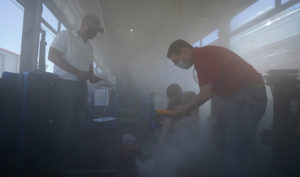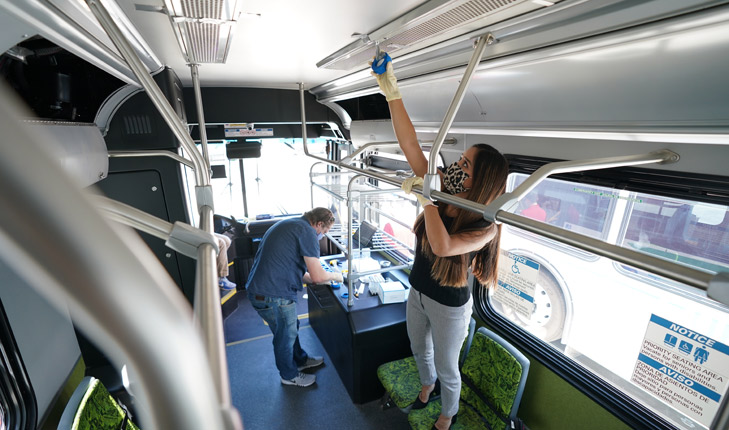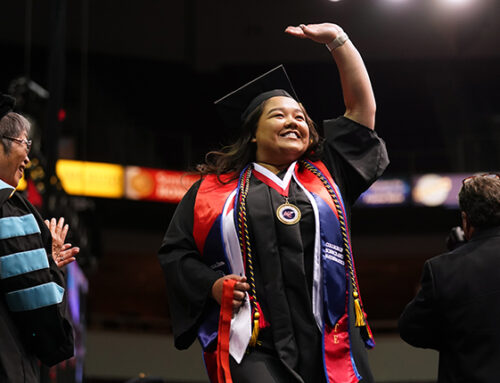 A team of researchers and industry professionals led by the Fresno State Transportation Institute has found ways to reduce the spread of airborne viruses, such as COVID-19, on modes of public transportation.
A team of researchers and industry professionals led by the Fresno State Transportation Institute has found ways to reduce the spread of airborne viruses, such as COVID-19, on modes of public transportation.
The team studied airflow on five buses — including diesel-, compressed natural gas- and electric-powered vehicles — and tested different virus mitigation technologies in the lab and on the bus. The preliminary findings of this study identify several efficient and economically viable solutions that can enhance passenger safety and help the public transportation industry rebound from the challenges presented by a global pandemic.
- Photocatalytic oxidation inserts: This air purification technology has the ability to destroy very small particles, and it eliminated more than 99% of all viruses that entered the HVAC system during testing.
- UV-C light: This form of ultraviolet light eliminated almost 98% of all viruses that entered the HVAC system during testing.
- Positive pressure environment: Maintaining a higher pressure within the bus than exists outside the bus eliminated 100% of viruses found on surfaces during testing.
- Copper tape and fabric: Copper foil tape, as well as fabrics with higher copper percentages, eliminated one virus found on surfaces by 99.7%. However, the results were inconclusive with the other two viruses tested.
These technologies would not only protect passengers and drivers from COVID-19, but also other airborne viruses, such as the flu, the research team said.
The study also found that social distancing alone may not be effective in buses, as a virus can spread throughout the entire bus within seconds of being released. While retrofits for the bus and HVAC system with accessible and affordable materials can be efficient, Dr. Aly Tawfik, director of the Fresno State Transportation Institute, said face masks are still the first line of defense against the spread of COVID-19.
“Face masks are extremely important because these technologies will only clear the air after the virus reaches the HVAC,” Tawfik said. “These technologies will not only help protect passengers and drivers from the coronavirus, but also from other airborne viruses, such as the flu. So, they would be valuable even in post-corona times.”
At the onset of the COVID-19 pandemic, Bay Area Rapid Transit reported a 90% loss of ridership according to the March 2020 Congressional Research Service Insight report. The report also noted New Jersey Transit reporting a loss of 88%, New York’s Metropolitan Transportation Authority a loss of 60% in subway ridership alone and Denver’s Regional Transportation District reported a 60% loss. Tawfik said that even when transit runs at full capacity, it doesn’t make a profit.
“Public transportation ridership has been significantly down since COVID-19 started spreading in the United States – impacting public transit agencies across the nation,” Tawfik said. “Many people, including essential workers, rely on public transportation. “But because of COVID-19, so many are not using public transit because they fear for their safety and health. We wanted to do something to help both passengers and drivers.”
According to the U.S. Department of Transportation’s Bureau of Transportation Statistics, Americans took nearly 3 billion fewer trips over the 2020 Labor Day weekend in comparison to more than 7 billion in 2019.
“Transit is sometimes 80% or 90% subsidized, and if you cut this by another half, transit agencies cannot continue to operate with such huge losses,” Tawfik said.
The Science Behind the Study
The team initially used non-toxic colored candles, steam and computational fluid dynamics models to simulate the movement of airflow and airborne contamination. After completing the study on airflow circulation patterns on each bus, they began working to understand how to mitigate the virus from spreading inside the cabin.
“To determine infectious particle mitigation, three different bacteriophages, Phi6, MS2 and T7 – viruses of different sizes and structures – were used. Phi6 most resembles SARS-CoV-2, while the other two viruses allow us to determine how these devices can affect other possible circulating viruses. All the viruses infect bacteria, not humans, so they were safe to use in this testing process,” said Dr. Juris Grasis, assistant professor in molecular and cell biology at University of California, Merced. “We feel confident that we can eliminate the infectivity of the coronavirus and other viruses that may be even more difficult to eliminate.”
The COVID-19 public transportation study consisted of transit buses from Fresno County Rural Transit Authority and Clovis City Transit. Each bus was used to capture the conditions in the bus cabin under different vehicle motion and operation scenarios.
“Air circulation patterns and spread of airborne contaminants were captured using smoke, steam and a computational fluid dynamics model that simulates the flow of fluid in the bus cabin under different vehicle motion and operation scenarios,” said Dr. Deify Law, associate professor of mechanical engineering at Fresno State. “Generally, the air moved from the ceiling of the bus cabin towards its floors and formed the air circulation. The air was observed concentrating towards the middle and back of the bus and moving towards the front of the bus. We found that the virus was spread throughout the bus in seconds, but takes minutes to clear.”
Tawfik and the team concluded that under normal cooling conditions, viruses are mitigated up to 85% and that public transportation may be safer in the winter since higher HVAC heating temperatures alone mitigate a large percentage of viruses. Presuming this is due to two factors: heat mitigating the virus, and by drying out the aerosol particles to which the viruses can attach.
An expert in the area of aerosols, Dr. Sheryl H. Ehrman, Don Beall dean of the Charles W. Davidson School of Engineering at San Jose State University said, “The first step toward solving a problem is characterizing the problem, and their interdisciplinary work to understand how viruses, including other viruses like influenza, might spread, takes that first step. I think this work is a great example of CSU research that is relevant and timely, and I believe this study provides important information we need right now for decision making. Many people in our community are dependent on public transportation to get to their essential jobs and run essential errands, and we need to know the risks associated with public transportation so that we can find solutions to reduce risk.”
The full published peer-reviewed report will be available January 2021. Tawfik said the team is also pursuing additional research grant opportunities to test the long-term efficiency of virus mitigation.
This study was funded by the California State University Transportation Consortium. Transit agencies Fresno County Rural Transit Authority and Clovis City Transit provided support to this study. Professional industry collaborators include Joseph Oldham, project manager, Fresno Metro Ministry, Inc. and Moe Salem, chief technology officer for Air2O Cooling, LLC.





